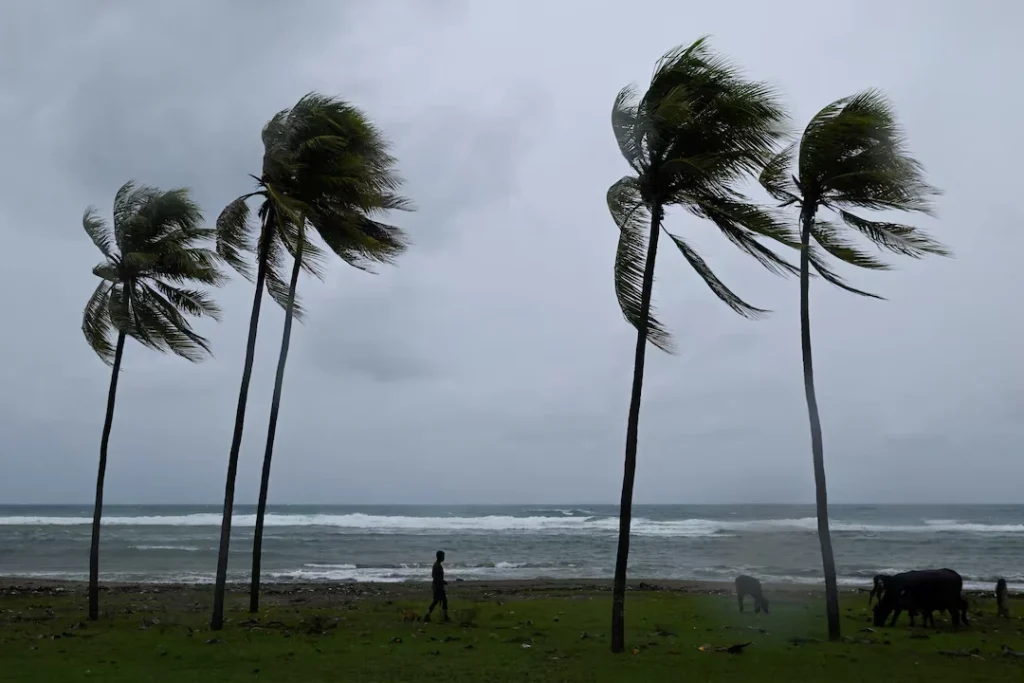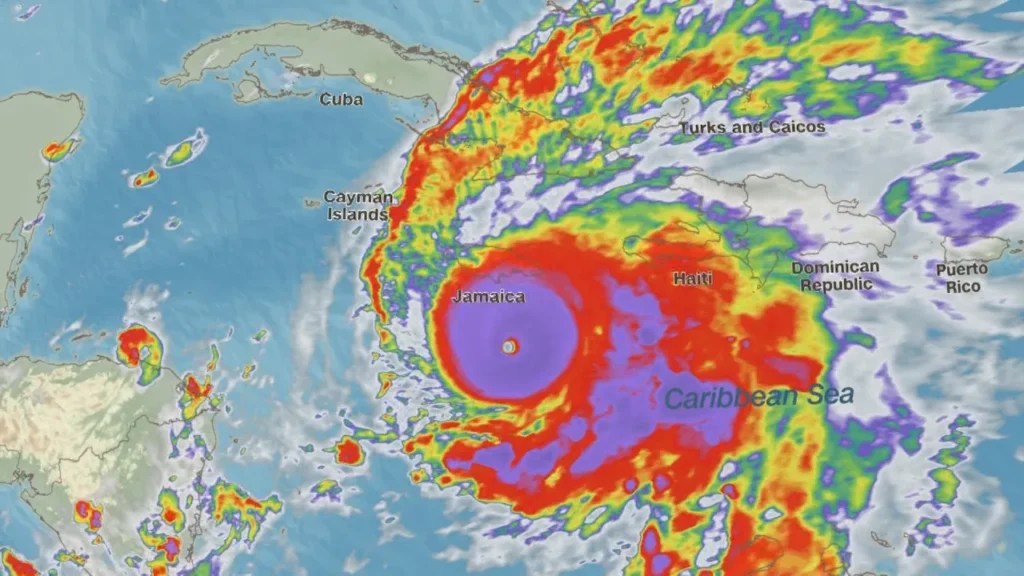When Jamaica storm Hurricane Melissa struck the island in late October 2025, it marked one of the most powerful and devastating weather events in the Caribbean’s recent history. With sustained winds exceeding 185 mph and torrential rains that caused catastrophic flooding, the storm left behind widespread destruction, heartbreak, and an urgent call for stronger climate resilience.
This article explores how Hurricane Melissa formed, how Jamaica prepared and responded, the scale of its impact, and what lies ahead for the island as it rebuilds in the wake of one of nature’s most furious storms.

The Birth of a Monster: How Hurricane Melissa Formed
Hurricane Melissa began as a tropical disturbance off the coast of West Africa in mid-October 2025. As it drifted westward across the Atlantic Ocean, it slowly gathered strength. Warm sea surface temperatures, high humidity, and minimal wind shear created perfect conditions for rapid intensification.
By the time the system entered the Caribbean Sea, meteorologists were already warning that it could become a major hurricane. Within 48 hours, Hurricane Melissa transformed from a Category 2 storm into a catastrophic Category 5 an explosive intensification rarely seen in the region.
Experts from the World Meteorological Organization noted that Jamaica storm Hurricane Melissa was the result of record ocean heat levels and changing atmospheric patterns influenced by climate change. These conditions allowed the storm to maintain its strength for longer than typical hurricanes, increasing its destructive potential.
Jamaica on High Alert: Preparation Before the Storm
As forecasts grew more alarming, Jamaican authorities issued a series of warnings urging residents to prepare for what could be the worst storm in the island’s history. Emergency shelters were opened, disaster response teams were activated, and coastal communities were advised to evacuate.
However, despite these warnings, many residents chose to stay home. Limited resources, transportation challenges, and a sense of disbelief that the storm could truly be that strong led to underpreparedness in several areas.
Government agencies, local councils, and volunteers worked tirelessly in the days before landfall to distribute food, secure shelters, and strengthen critical infrastructure. Schools were converted into evacuation centers, and hospitals stocked up on emergency supplies.
When Hurricane Melissa finally reached Jamaica’s southwestern coast near the parish of St. Elizabeth, it brought with it winds over 180 mph and a storm surge exceeding 12 feet. The island had never faced such raw power.
The Moment of Impact: Jamaica Faces the Full Force
The first signs of destruction appeared even before the eye of the hurricane reached land. Roofs were torn from buildings, power lines collapsed, and trees snapped like matchsticks. Entire neighborhoods were left without electricity within hours.
In St. Elizabeth and Westmoreland parishes, storm surge swallowed coastal roads, flooding homes and businesses. Heavy rainfall triggered landslides in the mountainous regions, cutting off entire communities from aid and rescue operations.
The Jamaica storm Hurricane Melissa was relentless it stalled over the island for nearly 10 hours, unleashing torrential rains that overwhelmed rivers and reservoirs. Emergency responders described it as “a night that felt endless.”
Key reports from local officials indicated:
- Over one-third of the island’s residents lost electricity.
- Dozens of hospitals and clinics sustained severe damage.
- Agricultural fields, especially sugarcane, banana, and coffee plantations, were destroyed.
- Coastal infrastructure, including ports and highways, suffered massive erosion.
By sunrise, Jamaica was a landscape of destruction.

Why Hurricane Melissa Was Different
What made Hurricane Melissa stand out from previous hurricanes wasn’t just its strength it was the combination of factors that amplified its impact.
- Extreme Intensity at Landfall: Melissa made landfall as a Category 5 hurricane, making it the strongest storm ever recorded to hit Jamaica directly.
- Slow Movement: The storm’s slow forward speed prolonged rainfall and wind exposure, intensifying damage across multiple regions.
- Geographic Vulnerability: Jamaica’s mountainous terrain increased the risk of landslides and flash floods, especially in central and southern parishes.
- Climate Connection: Scientists pointed to unusually warm Caribbean waters fueled by climate change as a key driver of the storm’s unprecedented strength.
Climate experts have since warned that Jamaica storm Hurricane Melissa could become the “new normal” for tropical weather systems in the region if global warming continues unchecked.
The Human Side of the Disaster
Behind every statistic from Hurricane Melissa lies a story of loss, resilience, and courage. Families were forced to flee their homes in waist-deep water, parents shielded children from collapsing roofs, and communities came together to rescue neighbors trapped by floods.
One resident from Manchester parish described the moment the storm hit: “It was like the island was breathing roaring, shaking. You couldn’t see anything but rain and debris flying in every direction.”
Many survivors lost everything. Homes were flattened, livelihoods destroyed, and entire towns were left without access to clean water or communication. Despite these hardships, the Jamaican spirit of unity shone brightly as volunteers, churches, and local organizations mobilized to distribute aid.
The Aftermath: Assessing the Damage
In the days that followed, Jamaica’s government declared a national emergency. Search and rescue teams scoured affected areas, and helicopters delivered aid to isolated communities.
Initial assessments estimated billions of dollars in damage. Infrastructure, including roads, bridges, and power grids, suffered extensive destruction. The agricultural sector was among the hardest hit, with thousands of acres of crops lost.
International organizations, including the Red Cross, the United Nations, and regional disaster relief agencies, arrived to support recovery efforts. Humanitarian aid began flowing in, though logistical challenges slowed distribution.
Hospitals in Kingston and Montego Bay operated on backup generators, while relief shelters reached full capacity. Schools remained closed, and transportation networks were disrupted for weeks.
The Road to Recovery
Rebuilding after Jamaica storm Hurricane Melissa will be a long and difficult process. Experts estimate it could take years for the island to fully recover, especially in rural and agricultural areas.
Short-term recovery priorities include:
- Restoring power and clean water access.
- Clearing roads to reconnect isolated communities.
- Providing temporary housing for displaced families.
- Supporting farmers and small businesses affected by the storm.
- Ensuring health and sanitation systems prevent outbreaks of waterborne diseases.
In the long term, Jamaica faces a crucial decision: to rebuild stronger and more resilient. This means updating building codes, improving early warning systems, and investing in climate-adaptive infrastructure.
Government officials and international partners have pledged to make recovery not just about restoration but transformation.

Climate Change and the Future of Caribbean Storms
Hurricane Melissa has reignited urgent discussions about climate resilience in the Caribbean. Scientists say that rising ocean temperatures are leading to more intense and unpredictable storms.
The Caribbean region contributes less than 1% to global carbon emissions but faces the brunt of climate-related disasters. The case of Jamaica storm Hurricane Melissa highlights the inequality of climate impact: small island nations endure catastrophic losses despite minimal contribution to the global problem.
Environmental advocates are calling for stronger international support both financial and technological to help countries like Jamaica adapt to a rapidly changing climate.
This includes investments in:
- Sustainable energy and disaster-resistant housing.
- Reforestation and mangrove restoration to protect coastlines.
- Improved meteorological systems for earlier, more accurate storm predictions.
Lessons from Hurricane Melissa
Every major disaster teaches lessons, and Hurricane Melissa is no exception. Jamaica’s experience underscores several key points:
- Preparedness saves lives – Early evacuation and effective communication are vital.
- Infrastructure resilience matters – Buildings must be constructed to withstand stronger storms.
- Community networks are powerful – Grassroots cooperation proved essential in immediate relief.
- Climate adaptation can’t wait – Future hurricanes are likely to be even stronger if global action is delayed.
The storm’s aftermath is a sobering reminder that resilience is not only about rebuilding structures but about building systems, policies, and communities that can endure future challenges.
The Jamaican Spirit: Rising Again
Even amid destruction, hope persists. Across the island, communities are already rebuilding, neighbors are helping each other clear debris, and local volunteers are providing meals and shelter to those in need.
Jamaicans have weathered many storms before, but Hurricane Melissa will be remembered as a defining moment a test of endurance, unity, and faith.
In the words of one volunteer in Kingston: “We’ve lost much, but not our spirit. Jamaica will rise again stronger, wiser, and ready.”
Final Thoughts: What Comes Next
As the world watches Jamaica’s recovery, Jamaica storm Hurricane Melissa stands as both a warning and a lesson. It warns of the accelerating risks posed by climate change and the fragility of island ecosystems. Yet, it also shows the remarkable strength of human resilience in the face of nature’s fury.
For Jamaica, rebuilding isn’t just about replacing what was lost it’s about reimagining the future. The path forward will be difficult, but with unity, innovation, and international support, the island can emerge stronger than before.
Hurricane Melissa will forever be etched in Jamaica’s history as a symbol of both devastation and hope a storm that tested a nation, and a nation that refused to break.